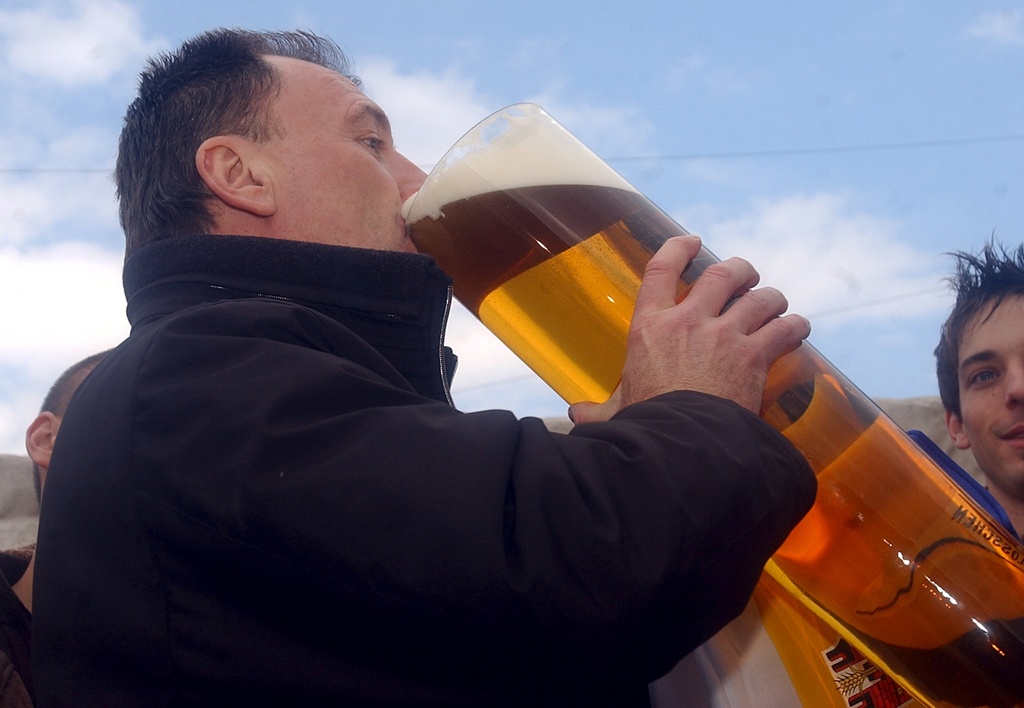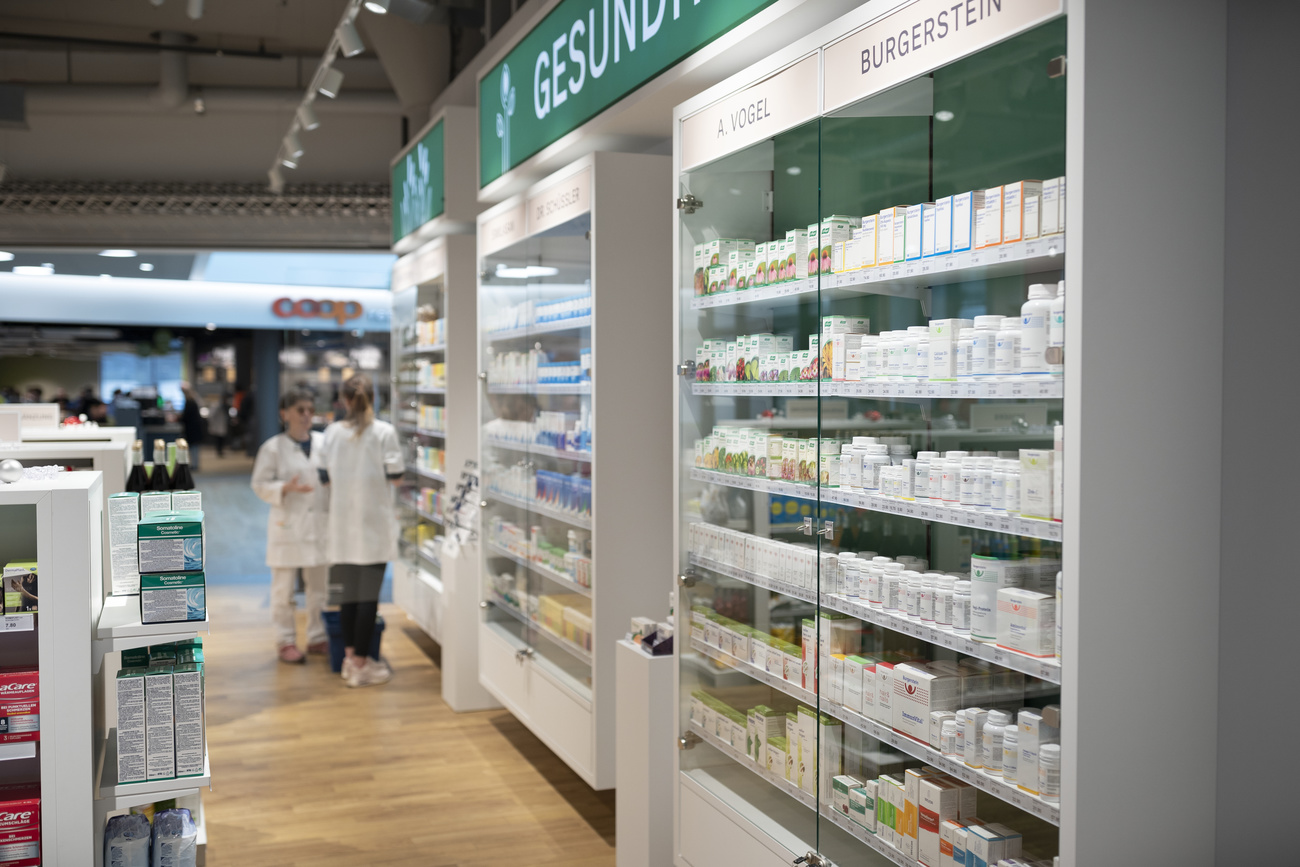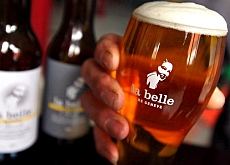Brewers face beer group pressure

Following the announced closure of the Cardinal brewery in Fribourg, swissinfo.ch looks at whether the glass is half-full or half-empty for the Swiss beer industry.
“You can’t be a real country unless you have a beer and an airline,” reckoned musician Frank Zappa. “It helps if you have some kind of a football team or some nuclear weapons, but at the very least you need a beer.”
By Zappa’s definition, Switzerland is barely a microstate, having seen Swissair grounded in 2001, its football team unable to beat Honduras in the recent World Cup (although they did beat eventual winners Spain) and its last big independent brewery, Eichhof, taken over by Heineken in 2008.
On Tuesday Danish beer giant Carlsberg announced it was closing the traditional Cardinal brewery in Fribourg and that it would concentrate production of beer for the Swiss market in Rheinfelden, the home of Feldschlösschen, which Carlsberg bought in 2000.
Local beer lovers are hopping mad: street protests are planned and there is even talk of boycotting Carlsberg products. A Facebook site to save the brewery has already collected 15,000 signatures.
Marcel Kreber, director of the Swiss Brewers’ Association, puts on a brave face, saying the Swiss beer market is currently “very dynamic – we have three times as many breweries [301] as we did ten years ago”.
But although per capita beer consumption in Switzerland has been relatively stable in recent years at around 57 litres a head, this is down from 71 litres in 1990.
Alehouse rock
Indeed, the average Austrian and German downs almost twice as much beer as his or her Swiss neighbour – 101 and 112 litres a year respectively (although both are way behind the European champions in the Czech Republic who get through a blinding 160 litres of beer a year each).
Kreber says he wants to revolutionise the way Swiss people think about beer.
“If you go into a restaurant, you order ‘a beer’. Why don’t we ask for beer as we do for wine and ask waiters what kind of beer they have?”
To this end, the Swiss Brewers’ Association is planning, along with the federation of hoteliers and restaurateurs Gastrosuisse and the Doemens Brewing Academy in Bavaria, a school for beer sommeliers.
“We want to improve the knowledge of restaurant staff in order to be able to recommend certain beers for certain food.”
Catching up
“We don’t have the Stammtisch culture any more where tables in pubs or restaurants are reserved for regulars,” Kreber told swissinfo.ch.
“Also, the laws against passive smoking and the impact of the economic crisis mean people aren’t spending as long drinking in restaurants,” he said, adding that more people are buying beer in supermarkets and taking it home.
Advertising is an obvious solution, but until February this year beer and wine adverts were banned on Swiss television and radio.
“German brewers could always advertise on German channels [found in all Swiss-German households] and so we always watched German beer ads but couldn’t make our own,” Kreber complained.
“We’re still catching up. We’re behind Germany and Austria who have long beer traditions. There’s a lot of beer to be explored by the Swiss people.”
Under pressure
Another concern for Kreber is the gradual increase of foreign beer flowing into the country. Last year 925,000 hectolitres were imported – 20 per cent of the total consumed.
“It’s not a good sign. Swiss breweries are facing pressure because if consumption is stable but there are more imports and new competitors, someone has to pay the price.”
The Swiss beer market is dominated by two multinational brewers: Carlsberg (45 per cent) and Heineken (30 per cent). The rest is local breweries and microbreweries, mostly in German-speaking Switzerland.
Kreber believes that on balance this duopoly is not detrimental, pointing out that the big internationals employ Swiss workers, use Swiss ingredients and guarantee a consistently good-quality product.
He also says there are benefits for small and medium-sized breweries who work with the multinationals. “The small ones have the hearts of the people because they are brewing speciality beers, but they’re not as strong on the logistical side.”
Path of yeast resistance
Jérôme Rebetez, owner of the Franches-Montagnes Brewery in the western village of Saignelégier (see gallery), isn’t so sure.
“In the restaurant and café market Carlsberg and Heineken have something like an 80-85 per cent market share. As a small brewer you have to fight against that and make people aware of the situation. They often don’t know they’re drinking the same beer from the same group,” he told swissinfo.ch.
“What’s sad for me is that nowadays we no longer have a choice – we just drink international brands.”
Rebetez produces around 300,000 bottles a year, 20 per cent of which go abroad, and for him the biggest challenge for small breweries in Switzerland is getting their beers into pubs and restaurants on draught.
“Restaurants and bars always have financial problems and the banks don’t finance them, so the breweries help them to start up in return for exclusivity contracts,” he said.
“In the United States it’s forbidden to have a contract that obliges the owner to serve a particular beer. They can serve whatever they want.”
Thirst come, thirst served
As for exports, demand in China is estimated to be growing by ten per cent a year, resulting in an Asian beer battle between the “big four” – Anheuser-Busch InBev, SABMiller, Heineken and Carlsberg – who account for over half the global market. Are the Swiss planning to join the party?
“I was in China two years ago but it’s still quite a complicated market,” Rebetez said. “I have more confidence in Scandinavia. The US market is quite easy and interesting for us and maybe Japan. For China I think we’ll have to wait five or six years.”
Kreber said that the Swiss pavilion at the Shanghai World Expo featured Schützengarten beer from St Gallen, which went down a treat. The problem again was logistics.
“Brewing beer is not very complicated,” he said. “Getting it to the clients is.”
Thomas Stephens, swissinfo.ch
In 2009 Swiss brewers produced 3.55 million hectolitres (2.2 million barrels/94 million gallons) of beer (excluding alcohol-free beer and exports). A hectolitre is 100 litres.
4.48 million hectolitres of beer was drunk (20.7% imports) – an equivalent of 57.2 litres per head.
925,000 hectolitres were imported from 74 countries and 53,000 hectolitres exported to 33 countries.
Consumption of beer generated SFr310 million ($305 million) for the government in taxes and excise.
Germany remained Europe’s largest beer producer (103 million hl), followed by Britain (49.5 million hl), Poland (36.9 million hl) and Spain (33.4 million hl).
In 2009, 79.3% of Swiss beer produced was lager, 14.7% special beer (brewed for special occasions) and 6% speciality beer (made with special ingredients).
17 breweries produce 100,000-2,000,000 hl.
In 2008 there were roughly 260 microbreweries. Of those, 250 produce less than 2,000 hl.
The Swiss beer industry creates a total of 28,000 jobs which generate value added of €1.255 billion (SFr1.63 billion). More than three-quarters of this value added is in the hospitality industry. 2,250 people are employed by breweries.
55% of beer consumption is beer sold in supermarkets and other retail outlets; 45% is sold by the hospitality sector.
(Sources: Swiss Brewers’ Association/Brewers of Europe/Ernst & Young)

In compliance with the JTI standards
More: SWI swissinfo.ch certified by the Journalism Trust Initiative














You can find an overview of ongoing debates with our journalists here . Please join us!
If you want to start a conversation about a topic raised in this article or want to report factual errors, email us at english@swissinfo.ch.